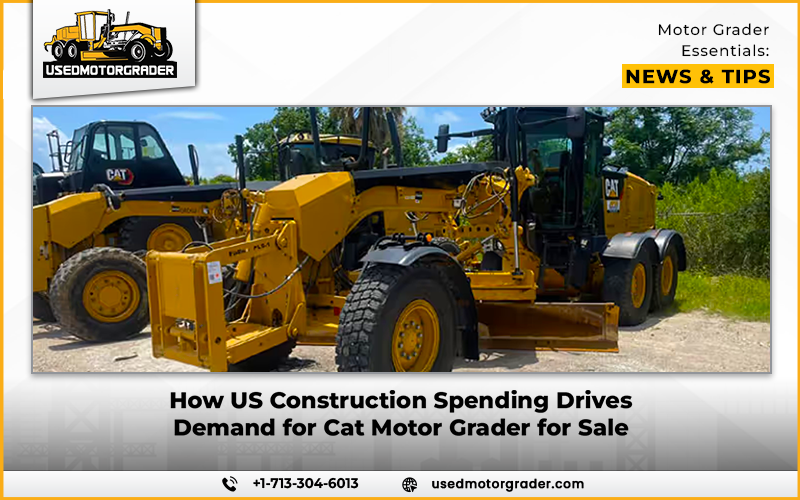Federal Infrastructure Bills as Market Catalysts
Once the U.S. government invests billions of dollars in infrastructure renewal, the ripple effect goes far into the heavy equipment market. The Bipartisan Infrastructure Law (BIL) of 2021 included more than 1.2 trillion to fix roads, bridges, railways, and broadband networks. This money will mean more projects for contractors and municipalities alike, and more equipment. Most of these projects center around the motor grader, particularly the highly rated Cat models that companies recognize for their reliability. Since funding is being converted into projects, the demand for models of Cat motor grader for sale is increasing, and buyers are rushing to get units before backlogs occur.
Timing the Market: Spending Rollouts and Equipment Demand Surges
The officials do not release the federal infrastructure dollars immediately. It releases funds on a schedule, typically based on state approvals, grant applications, and project planning cycles. That causes predictable demand surges. In normal years, the second and third quarters are typically the busiest, as state budgets are in sync with federal funding and contractors get busy purchasing in anticipation of the busy construction season. At such periods, Cat motor grader for sale models are hot items, particularly new or low-hour Cat motor graders. Customers who purchase products slightly before such waves are able to save on prices and avoid long queues.
Municipal and Contractor Buying Patterns
Public agencies, particularly state DOTs and city works departments, tend to buy in clusters, especially when budgets are flush with infrastructure funds. They often prefer Caterpillar equipment due to its longstanding reputation, parts availability, and dealer support. For many municipalities, reliability isn’t a preference. It’s a requirement. That means Cat motor grader for sale models become the first-choice upgrade when existing fleets are due for replacement. In response, contractors who previously bought new might pivot to used Cat models, driving further demand in the secondary market. It creates a cascading effect across equipment tiers, with even older machines holding strong resale value.
Private Sector Reaction to Public Investment
When public money flows, the private sector doesn’t stay idle. General contractors, site prep firms, and energy developers watch infrastructure funding closely and invest in equipment that will allow them to compete for public contracts. Contractors especially seek Cat motor graders because they’re versatile, rugged, and easy to pair with grade control technologies, which are now a standard expectation in many infrastructure bids. As private operators expand their fleets to meet demand from roads, wind farms, and transit projects, the demand for available Cat motor graders intensifies, putting pressure on dealers and auction markets alike.
Why Cat Graders Hold Strategic Value in Infrastructure Projects
That is why Cat motor graders tend to be at the forefront of the work with public infrastructure. The machines are designed to be reliable under pressure- those projects where time is of the essence, where downtime is expensive. Advanced hydraulic controls, grade control integration, and operator-friendly cabins are some of the features that make them suitable for working in long shifts and on different terrains. Add to that, Caterpillar has a wide network of dealers, so parts, support, and financing are never far away. This strategic worth, particularly in high-profile projects on short schedules, renders Cat motor graders more than a buy. They are a competitive edge.
Used Market Ripples: Pricing Shifts and Regional Imbalances
The used equipment market does not remain silent as the demand for new graders increases. Indeed, it is usually the first to respond. The used Cat motor graders are often sought by contractors who want to evade long lead times or high interest rates. That increases resale values, particularly in states with ambitious infrastructure programs such as Texas, Florida, and California. Shortages in a region form rapidly, and it leads to cross-border buying or even exportation. A few lightly used machines exported, decreasing the supply in the country and causing upward pressure on values. It is a time of opportunity for the sellers and a time of speed and flexibility for the buyers.
Inflation, Interest Rates, and Buy-vs-Lease Dynamics
The way these equipment decisions are implemented is very crucial to the macroeconomic situation. The increase in interest rates that usually accompanies the increase in federal spending makes long-term financing of equipment more costly. That pushes buyers, particularly smaller contractors, toward second-hand machines or lease deals. Such constraints make the Cat motor graders safer because they are worth more than many other competitors. Leasing is also becoming popular, and this enables the firms to control cash flow even as they continue to engage in federally funded projects. The economic perspective, no less than the mechanical one, is shaping the way buyers perceive and appreciate Cat motor graders in the present.
Long-Term Impact: Equipment Lifecycles in Post-Bill America
The infrastructure boom is not simply temporary. It is transforming the equipment market over the next few years. With the funds still rolling out into 2026 and beyond, the need to have graders will remain, especially with the labor shortage, which is necessitating increased use of machine accuracy. To those who own Cat motor graders, it translates into longer value, working life, and resale demand. Fleet managers can postpone rotation or invest in upgrading rather than replacing, where machine utilization is still high. Customers are bound to find the Cat name, which already has longevity attached to it. Even more significant as they seek out machines that will stand up to economic cycles as well as wear and tear at the jobsite.


